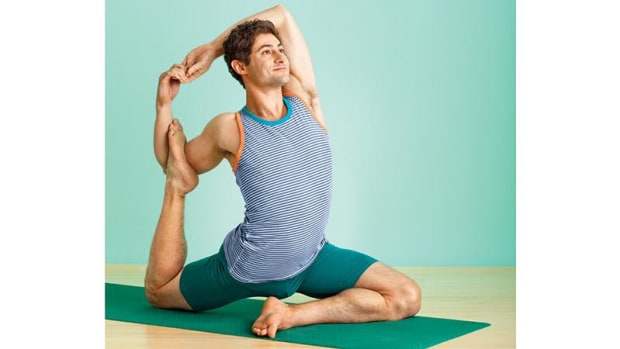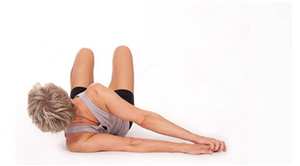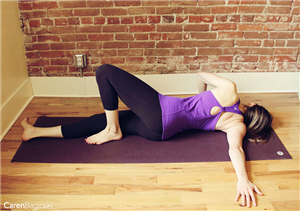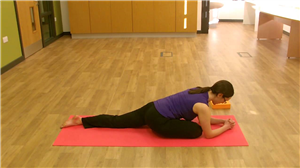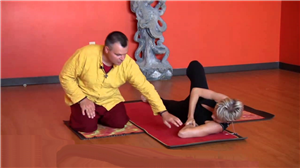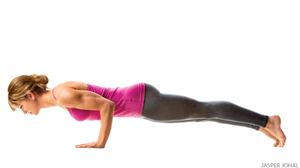Why Yoga Needs New Arm Stretches
"No yoga school developed poses equally for the legs and arms," he says, "and most poses that train the arms focus on strength." Of the few poses that focus on arm flexibility, most are active stretches, like Viparita Namaskar, Gomukhasana (Cow Face Pose), and Garudasana (Eagle Pose), which use the strength of one set of muscles to stretch others. To create different and much deeper stretches for the arms and shoulders, Lappa developed the series of passive stretches presented here.
1. Eka Bhuja Swastikasana I
In One-Armed Swastika Pose I, your body looks like one of the crosspieces of the ancient Asian symbol of good luck.
To come into the pose, lie face-down with your arms stretched out perpendicular to your sides, palms down. Make sure your hands are level with your forehead rather than stretched straight out from your shoulders. On an exhalation, without moving your right arm, roll onto your right side and reach your left hand straight back toward your right one. Bend your left knee and bring the sole of your foot to the floor. Draw your spine long, extending down through your tailbone toward your feet and up through the crown of your skull, and turn your head to the left so you look up toward the ceiling. (If this neck position isn't comfortable, experiment until you find one that is.)
2. Eka Bhuja Swastikasana II
To come into One-Armed Swastika Pose II, lie face-down with your arms reaching straight up overhead and your palms on the ground, shoulder-width apart. To keep your body integrated and engaged as you enter the arms stretch, place the inner edges of your big toes together and extend energy down through your tailbone and legs and up through the crown of your head. On an inhalation, draw your elbows in toward your torso until they're almost underneath your shoulders, and rise up into a mild Sphinx Pose.
3. Eka Bhuja Padmasana
To come into One-Armed Lotus Pose, begin with the most basic version of the previous pose, Eka Bhuja Swastikasana: right arm crossed under the left and the left arm stretched back along your left side, palm up. Then lift your head off the floor, curl your right fingers around your thumb to form a fist, and bend your right elbow so you can swing your right wrist directly underneath your chin; the whole inner edge (thumb side) of your right forearm, wrist, and hand will come to the floor.
4. Eka Bhuja Virasana
To come into One-Armed Hero Pose, lie on your back with your legs together, arms at your sides, and palms down. Next, bend your right knee, put the sole of your foot on the floor, and roll just a little to your left. Bending your right elbow, bring your right hand and wrist under the back of your right rib cage as close to your right shoulder blade as possible. Then slowly roll back to the right, letting the full weight of your torso rest on your right hand. Make sure your hand is far enough under your body so you immobilize your wrist rather than just rest on your fingers. Then straighten your right leg again.
5. The Rack
Don't let the name scare you. Doing this pose shouldn't be a painful experience; Lappa swears he simply gave it that label because its shape reminds him of the medieval instrument of torture.
To come into The Rack, sit upright in Dandasana (Staff Pose), spine tall and feet together and straight out in front of you. Then, leaning back, place your palms shoulder-width apart on the ground about 18 inches behind you. Keeping your arms straight by extending energy from your shoulder out through your fingertips, walk your hands back. As you do this, let your upper back round and drop toward the floor, your shoulder blades move up, and your chin sinks onto your upper chest. Throughout the pose, keep your body alert and integrated by extending energy out through your arms, keeping your thigh muscles engaged, and pushing gently but firmly out through the heels and balls of your feet. When you reach an edge in your stretch—you may feel this most at your inner upper arm, outer upper chest, and at the crease of your elbow—breathe smoothly and evenly for 15 to 45 seconds; if possible, allow your exhalations to move you slightly deeper into the pose. Then draw yourself back up until you're sitting erect with your spine and chest lifted.



 Contact Us
Contact Us







 Hospitals
Hospitals
 Doctors
Doctors
 Diagnostic
Diagnostic
 Pharmacy
Pharmacy
 Health Tips
Health Tips
 Blog
Blog










